How to handle a disruptive student |
|||
 Disruptive students, whether in kindergarten or high school, can be stressful for teachers and for a classroom's environment. If a teacher does not properly handle a student's disorderly conduct the instructor can quickly lose control of the class or lose student respect. Knowing this, you should be prepared and have a plan in place in case a situation should arise. Different instructors will have a variety of techniques, but there are a few key tactics a teacher should follow when dealing with a difficult student. Address the whole room Speak in private Remain rational and objective Engaging with disruptive students can be challenging, though, and sometimes even when a teacher calmly addresses a student's behavior and offers help, the student will still become explosive. If a pupil is being confrontational and uncooperative, one of the best actions you can take is to disengage from the behavior. For example, if a child is complaining about an assignment or arguing it has worthless purposes, briefly explain its merits and then move on to assist another child. Arguing with the student will only make the scene worse. If the disruptive pupil continues hassling you about the work to the point that actions and comments are too contentious, ask them to go to the office. The American Federation of Teachers notes that by disengaging from these situations, teachers can quickly end a hostile interaction. Maintaining a calm demeanor and effectively dealing with the encounter will also make the class feel like you are in control as the teacher and will allow you to smoothly continue the lesson. |

|
||
